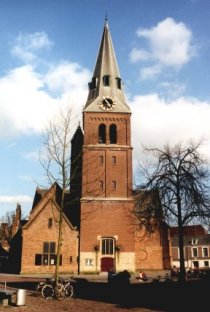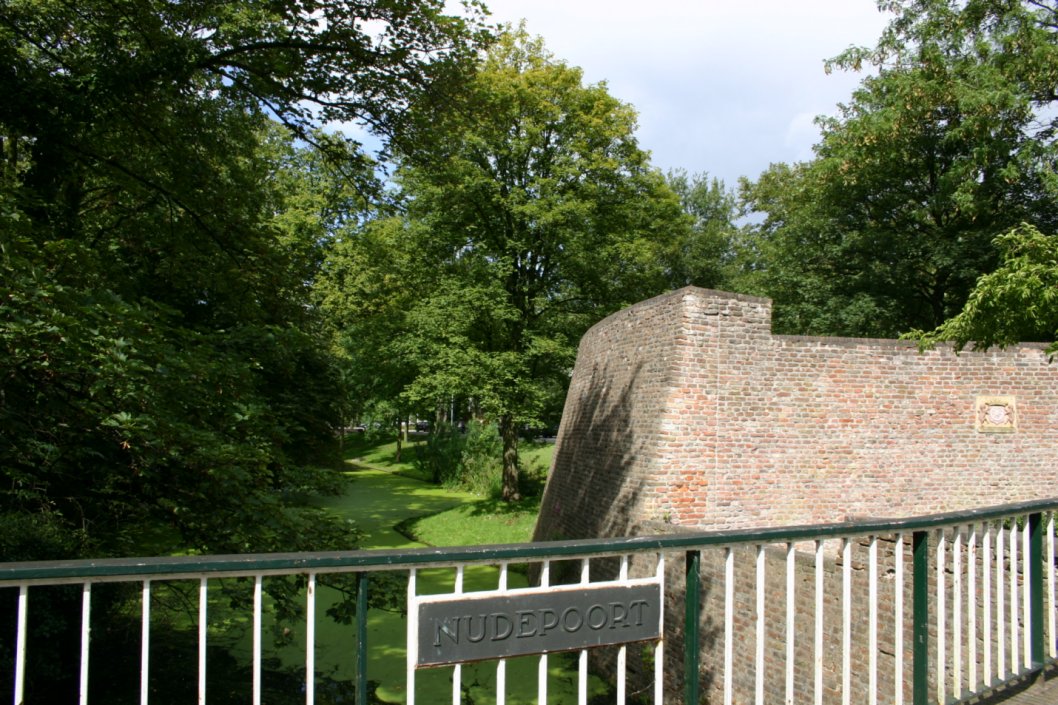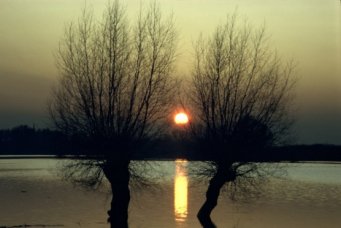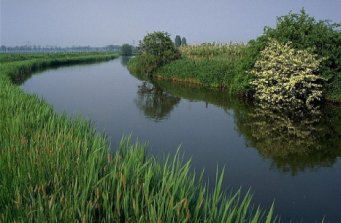|
Wageningen is a university city, the Liberation city, a ‘green’
city, a friendly city. And a compact city too. All the main points of
interest are within easy walking distance of each other. It combines
the charm of a historical fortified town on the river Rhine with the
dynamics of an internationally well-known university and high-tech research
centers. Wageningen received city rights in the year 1263. Old houses,
typical properties, and small friendly streets define the scene. Wageningen
is a university town with a student-like atmosphere that shows in its
lively nightlife. Also, Wageningen is known for its important role during
the Second World War. In May 1945, the German capitulation was signed
in hotel "De Wereld"
Character of the
city

Wageningen, The 5th of May, and the Liberation of the Netherlands are
inextricably linked. It was in Wageningen that the Germans surrendered
on 5 May 1945. Hotel De Wereld, where this historic event took place,
attracts visitors from all over the world, especially around the anniversary
of the surrender. The annual 5 May celebrations in Wageningen draw thousands
more visitors, including Veterans of the Allied forces.
The history of Wageningen as a city dates back to 1263. In that year,
Nijwageningen, as it was known then, received its franchise charter,
becoming the third most important city in the Veluwe region after Arnhem
and Harderwijk. The Church of John the Baptist, on the Market Square,
was completed in 1288. Most of it was destroyed during World War II,
but it has been rebuilt in the original Romanesque style. A castle was
built for defense in the 15th century after decades of sieges, occupations,
and sackings. It was razed in 1700, and the remnants of the old city
moat and walls are now the only reminders that Wageningen was once fortified.
The City Hall, also on the Market Square, dates from 1698. The old Latin
School on the Herenstraat dates from 1724.
 Signs
on many of the buildings call your attention to Wageningen’s position
as a national and international centre of agricultural research. Since
the founding of the Higher Agricultural School (now Wageningen
University) in 1918, the city has stimulated the development of
‘green’ expertise. The first fruits of this policy were the
two botanic gardens. Now there are many research institutes and related
organizations in addition to the University, and more than half of the
professional workforce is employed in the agricultural expertise sector.
The University has many courses for students from developing countries.
The large population of international and Dutch students adds an extra
dimension to Wageningen life. Signs
on many of the buildings call your attention to Wageningen’s position
as a national and international centre of agricultural research. Since
the founding of the Higher Agricultural School (now Wageningen
University) in 1918, the city has stimulated the development of
‘green’ expertise. The first fruits of this policy were the
two botanic gardens. Now there are many research institutes and related
organizations in addition to the University, and more than half of the
professional workforce is employed in the agricultural expertise sector.
The University has many courses for students from developing countries.
The large population of international and Dutch students adds an extra
dimension to Wageningen life.
Wageningen has a well-developed cultural life. The Junushoff Theatre
and the Heerenstraattheater cinema attract people from the entire region.
This is also true of the two weekly outdoor markets, the more than 150
shops and boutiques, and the many pubs and outdoor cafés that
stay open until the wee hours.
The area arond Wageningen
Geographically, Wageningen
is located at the meeting point of various types of landscapes. Because
of this, the natural environment here is more diverse than in many other
areas of the Netherlands. This makes it a wonderful place to explore,
by bicycle, by car, and on foot.
 Woodlands,
heathlands, hills, the Lower Rhine, floodplains, sand drifts —
only the sea is missing from the area around Wageningen. The area owes
this diversity of natural environment to its geographic location. It
lies on the Lower Rhine, in the foothills of the Veluwe massif. Various
types of landscapes meet here, giving the area its unique character.
From the top of the wooded Wageningse Berg, there is a scenic view of
the winding river and the fertile Betuwe region on the opposite bank.
The river is the natural boundary of the South-West Veluwe, which is
the geographic region surrounding Wageningen. Woodlands,
heathlands, hills, the Lower Rhine, floodplains, sand drifts —
only the sea is missing from the area around Wageningen. The area owes
this diversity of natural environment to its geographic location. It
lies on the Lower Rhine, in the foothills of the Veluwe massif. Various
types of landscapes meet here, giving the area its unique character.
From the top of the wooded Wageningse Berg, there is a scenic view of
the winding river and the fertile Betuwe region on the opposite bank.
The river is the natural boundary of the South-West Veluwe, which is
the geographic region surrounding Wageningen.
 This extends
west to Rhenen, a small city on the Grebbeberg. At the base of this
hill, directly on the river, is the Blauwe Kamer nature reserve, where
you can hike along the riverbanks. To the south of Wageningen is the
Bovenste Polder, the nature reserve for the Wageningen floodplain. To
the east is Oranje Nassau’s Oord, in the 19th century the country
estate of King William III. Consult the tourist
information for more information about these and many other places
of interest. This extends
west to Rhenen, a small city on the Grebbeberg. At the base of this
hill, directly on the river, is the Blauwe Kamer nature reserve, where
you can hike along the riverbanks. To the south of Wageningen is the
Bovenste Polder, the nature reserve for the Wageningen floodplain. To
the east is Oranje Nassau’s Oord, in the 19th century the country
estate of King William III. Consult the tourist
information for more information about these and many other places
of interest.
Last updated: 24
October 2005
|

 Signs
on many of the buildings call your attention to Wageningen’s position
as a national and international centre of agricultural research. Since
the founding of the Higher Agricultural School (now
Signs
on many of the buildings call your attention to Wageningen’s position
as a national and international centre of agricultural research. Since
the founding of the Higher Agricultural School (now  Woodlands,
heathlands, hills, the Lower Rhine, floodplains, sand drifts —
only the sea is missing from the area around Wageningen. The area owes
this diversity of natural environment to its geographic location. It
lies on the Lower Rhine, in the foothills of the Veluwe massif. Various
types of landscapes meet here, giving the area its unique character.
From the top of the wooded Wageningse Berg, there is a scenic view of
the winding river and the fertile Betuwe region on the opposite bank.
The river is the natural boundary of the South-West Veluwe, which is
the geographic region surrounding Wageningen.
Woodlands,
heathlands, hills, the Lower Rhine, floodplains, sand drifts —
only the sea is missing from the area around Wageningen. The area owes
this diversity of natural environment to its geographic location. It
lies on the Lower Rhine, in the foothills of the Veluwe massif. Various
types of landscapes meet here, giving the area its unique character.
From the top of the wooded Wageningse Berg, there is a scenic view of
the winding river and the fertile Betuwe region on the opposite bank.
The river is the natural boundary of the South-West Veluwe, which is
the geographic region surrounding Wageningen.  This extends
west to Rhenen, a small city on the Grebbeberg. At the base of this
hill, directly on the river, is the Blauwe Kamer nature reserve, where
you can hike along the riverbanks. To the south of Wageningen is the
Bovenste Polder, the nature reserve for the Wageningen floodplain. To
the east is Oranje Nassau’s Oord, in the 19th century the country
estate of King William III. Consult the
This extends
west to Rhenen, a small city on the Grebbeberg. At the base of this
hill, directly on the river, is the Blauwe Kamer nature reserve, where
you can hike along the riverbanks. To the south of Wageningen is the
Bovenste Polder, the nature reserve for the Wageningen floodplain. To
the east is Oranje Nassau’s Oord, in the 19th century the country
estate of King William III. Consult the